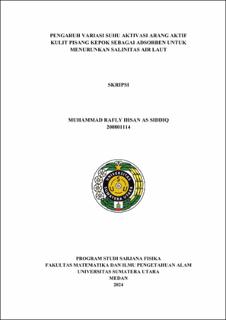Pengaruh Variasi Suhu Aktivasi Arang Aktif Kulit Pisang Kepok Sebagai Adsorben untuk Menurunkan Salinitas Air Laut
Influence of Activated Carbon from Kepok Banana Peel With Variation of Activation Temperature Asadsorbent to Reduce Seawater Salinity

Date
2024Author
Siddiq, Muhammad Rafly Ihsan As
Advisor(s)
Susilawati
Metadata
Show full item recordAbstract
Research on adsorbents based on activated carbon from banana peel has been
conducted for reducing seawater salinity. The peel was carbonized at 350˚C for
30 minutes. The activated carbon from banana peel was sieved using a 149 μm
(100 mesh) sieve. The activated carbon was then pressed using a hydraulic press
at 6 tons pressure for 10 minutes. The pressed adsorbents were subsequently
physically activated at different temperatures: 400˚C, 500˚C, and 600˚C for 4
hours each. The adsorbents based on activated carbon from banana peel were
characterized for their physical properties (porosity and water absorption
capacity), mechanical properties (hardness), SEM-EDS, XRD, FTIR, and surface
area (BET). These adsorbents were then applied to reduce seawater salinity. The
application testing was conducted in a batch reactor where 100 ml of seawater
and 10 grams of adsorbent material were simultaneously placed into a glass
beaker and stirred using a magnetic stirrer at 150 rpm for 2 hours. The results
showed that the adsorbents based on activated carbon from banana peel reduced
seawater salinity by 5.05% without activation, while activation at 500˚C reduced
seawater salinity by 25.78%. The percentage of salinity reduction increased with
higher activation temperatures, but decreased at 600˚C.
Collections
- Undergraduate Theses [1379]
